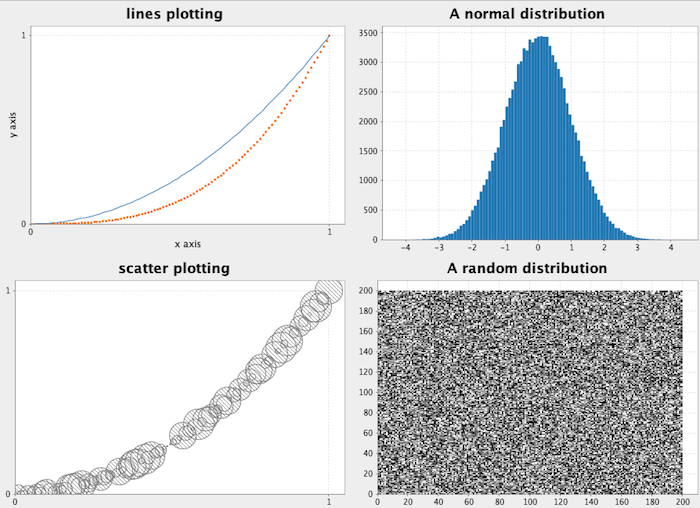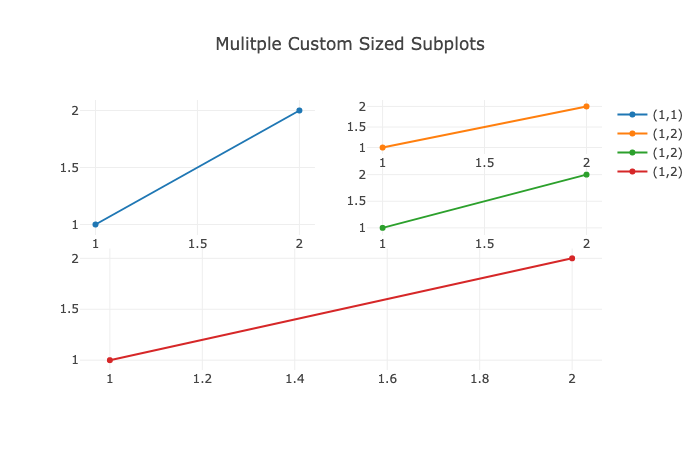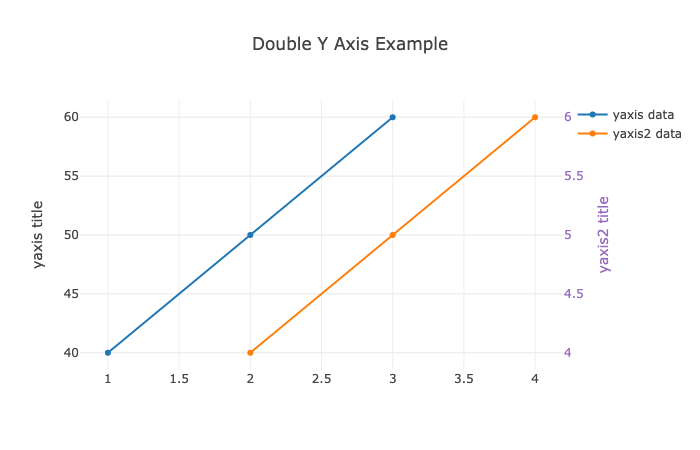Introduction
Breeze is a numerical processing library for Scala. It's a great tool for data science and machine learning. It's also used by Spark.
Visualization is important for data science and machine learning. Breeze provide breeze-viz for this. However it has only 4 kinds of plots -- line, scatter, histogram and image.
plotly-scala is the Scala bindings for plotly.js. It support a few of plots provided by plotly.
Here are some examples of both libraries based on their documentations.
Breeze-viz
import $ivy.`org.scalanlp::breeze:0.13.2`
import $ivy.`org.scalanlp::breeze-natives:0.13.2`
import $ivy.`org.scalanlp::breeze-viz:0.13.2`
import breeze.linalg._
import breeze.numerics._
import breeze.plot._
val fig = Figure()
val p = fig.subplot(0)
val x = linspace(0.0, 1.0)
p += plot(x, x ^:^ 2.0)
p += plot(x, x ^:^ 3.0, '.')
p.title = "lines plotting"
p.xlabel = "x axis"
p.ylabel = "y axis"
val p2 = fig.subplot(2, 2, 1)
val g2 = breeze.stats.distributions.Gaussian(0, 1)
p2 += hist(g2.sample(100000), 100)
p2.title = "A normal distribution"
val p3 = fig.subplot(2, 2, 2)
val x3 = linspace(0.0, 1.0, 100)
val size3 = 0.1 * DenseVector.rand(100)
p3 += scatter(x3, x3 ^:^ 2.0, size3.apply)
p3.title = "scatter plotting"
val p4 = fig.subplot(2, 2, 3)
p4 += image(DenseMatrix.rand(200, 200))
p4.title = "A random distribution"

Plotly
import $ivy.`org.plotly-scala::plotly-render:0.5.4`
import plotly._, element._, layout._, Plotly._
import $ivy.`org.scalanlp::breeze:0.13.2`
import breeze.linalg.DenseVector
implicit def fromDenseVectorDouble(v: DenseVector[Double]): Sequence = v.toArray.toVector
implicit def fromDenseVectorString(v: DenseVector[String]): Sequence = v.toArray.toVector
Scatter and Line
val trace1 = Scatter(
Seq(1, 2, 3, 4),
Seq(10, 15, 13, 17),
name = "marker",
mode = ScatterMode(ScatterMode.Markers))
val trace2 = Scatter(
Seq(2, 3, 4, 5),
Seq(16, 5, 11, 9),
name = "line",
mode = ScatterMode(ScatterMode.Lines),
line = Line(dash = Dash.Dot))
val trace3 = Scatter(
Seq(1, 2, 3, 4),
Seq(12, 9, 15, 12),
name = "line and marker",
mode = ScatterMode(ScatterMode.Lines, ScatterMode.Markers))
Seq(trace1, trace2, trace3).plot(title = "Line and Scatter Plot")

val trace1 = Scatter(
Seq(1, 2, 3, 4, 5),
Seq(1, 6, 3, 6, 1),
mode = ScatterMode(ScatterMode.Markers, ScatterMode.Text),
name = "Team A",
text = Seq("A-1", "A-2", "A-3", "A-4", "A-5"),
textposition = TextPosition.TopCenter,
textfont = TextFont("Raleway, sans-serif"),
marker = Marker(size = 12))
val trace2 = Scatter(
Seq(1.5, 2.5, 3.5, 4.5, 5.5),
Seq(4, 1, 7, 1, 4),
mode = ScatterMode(ScatterMode.Markers, ScatterMode.Text),
name = "Team B",
text = Seq("B-a", "B-b", "B-c", "B-d", "B-e"),
textposition = TextPosition.BottomCenter,
textfont = TextFont("Times New Roman"),
marker = Marker(
size = 20,
color = Color.RGB(142, 124, 195)))
Seq(trace1, trace2).plot(
"scatter.html",
Layout(
title = "Data Labels on The Plot",
xaxis = Axis(
range = (0.75, 5.25),
title = "x line title",
showgrid = false,
zeroline = false),
yaxis = Axis(
range = (0, 8),
title = "y line title",
showline = false)),
false,
true,
true)

Bubble
val trace1 = Scatter(
1 to 4,
10 to 13,
mode = ScatterMode(ScatterMode.Markers),
text = Seq("A<br>size: 40", "B<br>size: 60", "C<br>size: 80", "D<br>size: 100"),
marker = Marker(
color = Seq(Color.RGB(93, 164, 214), Color.RGB(255, 144, 14), Color.RGB(44, 160, 101), Color.RGB(255, 65, 54)),
opacity = Seq(1, 0.8, 0.6, 0.4),
size = Seq(40, 60, 80, 100),
symbol = Seq(Symbol.Circle(), Symbol.Square(), Symbol.Diamond(), Symbol.Cross())))
Seq(trace1).plot(
"bubble.html",
Layout(
title = "Bubble Chart Hover Text",
showlegend = false,
height = 600,
width = 600),
false,
true,
true)

Bar
val monthes = Seq("Jan", "Feb", "Mar", "Apr", "May", "Jun", "Jul", "Aug", "Sep", "Oct", "Nov", "Dec")
val trace1 = Bar(
monthes,
Seq(20, 14, 25, 16, 18, 22, 19, 15, 12, 16, 14, 17),
"Primary Product",
text = monthes.map(x => x + "!"),
// orientation = Orientation.Horizontal,
marker = Marker(
color = Color.RGB(49, 130, 189),
opacity = 0.7))
val trace2 = Bar(
monthes,
Seq(19, 14, 22, 14, 16, 19, 15, 14, 10, 12, 12, 16),
"Secondary Product",
text = monthes.map(x => x + "?"),
// orientation = Orientation.Horizontal,
marker = Marker(
color = Color.RGB(204, 204, 204),
opacity = 0.5))
Seq(trace1, trace2).plot(
"bar.html",
Layout(
title = "2013 Sales Report",
xaxis = Axis(tickangle = -45),
yaxis = Axis(
title = "Amount",
titlefont = Font(size = 20, color = Color.RGB(107, 107, 107))),
barmode = BarMode.Group,
bargroupgap = 0.1),
false,
true,
true)

Filled Area
val trace1 = Scatter(
1 to 4,
Seq(0, 2, 3, 5),
fill = Fill.ToZeroY)
val trace2 = Scatter(
1 to 4,
Seq(3, 5, 1, 7),
fill = Fill.ToZeroY)
Seq(trace1, trace2).plot()

Time Series
val src = scala.io.Source.fromFile("finance-charts-apple.csv")
val headers = src.getLines.take(1).next.split(",")
val datesBuf = collection.mutable.ArrayBuffer.empty[String]
val highsBuf = collection.mutable.ArrayBuffer.empty[Double]
val lowsBuf = collection.mutable.ArrayBuffer.empty[Double]
for (line <- src.getLines.map(_.split(","))) {
datesBuf += line(headers.indexOf("Date"))
highsBuf += line(headers.indexOf("AAPL.High")).toDouble
lowsBuf += line(headers.indexOf("AAPL.Low")).toDouble
}
val dates = DenseVector(datesBuf.toArray)
val highs = DenseVector(highsBuf.toArray)
val lows = DenseVector(lowsBuf.toArray)
val trace1 = Scatter(
dates,
highs,
mode = ScatterMode(ScatterMode.Lines),
line = Line(color = Color.StringColor("#17BECF")))
val trace2 = Scatter(
dates,
lows,
mode = ScatterMode(ScatterMode.Lines),
line = Line(color = Color.StringColor("#7F7F7F")))
Seq(trace1, trace2).plot(title = "Time Series")
src.close()

Subplots
val data = Seq(1, 2)
val trace1 = Scatter(
data,
data,
name = "(1,1)")
val trace2 = Scatter(
data,
data,
name = "(1,2)",
xaxis = AxisReference.X2,
yaxis = AxisReference.Y2)
val trace3 = Scatter(
data,
data,
name = "(1,2)",
xaxis = AxisReference.X3,
yaxis = AxisReference.Y3)
val trace4 = Scatter(
data,
data,
name = "(1,2)",
xaxis = AxisReference.X4,
yaxis = AxisReference.Y4)
Seq(trace1, trace2, trace3, trace4).plot(
"subplots.html",
Layout(
title = "Mulitple Custom Sized Subplots",
xaxis = Axis(
anchor = AxisAnchor.Reference(AxisReference.Y1),
domain = (0, 0.45)),
yaxis = Axis(
anchor = AxisAnchor.Reference(AxisReference.X1),
domain = (0.5, 1)),
xaxis2 = Axis(
anchor = AxisAnchor.Reference(AxisReference.Y2),
domain = (0.55, 1)),
yaxis2 = Axis(
anchor = AxisAnchor.Reference(AxisReference.X2),
domain = (0.8, 1)),
xaxis3 = Axis(
anchor = AxisAnchor.Reference(AxisReference.Y3),
domain = (0.55, 1)),
yaxis3 = Axis(
anchor = AxisAnchor.Reference(AxisReference.X3),
domain = (0.5, 0.75)),
xaxis4 = Axis(
anchor = AxisAnchor.Reference(AxisReference.Y4),
domain = (0, 1)),
yaxis4 = Axis(
anchor = AxisAnchor.Reference(AxisReference.X4),
domain = (0, 0.45))),
false,
true,
true)

Multiple Axes
val trace1 = Scatter(
1 to 3,
Seq(40, 50, 60),
name = "yaxis data")
val trace2 = Scatter(
2 to 4,
Seq(4, 5, 6),
name = "yaxis2 data",
yaxis = AxisReference.Y2)
Seq(trace1, trace2).plot(
"axes.html",
Layout(
title = "Double Y Axis Example",
yaxis = Axis(title = "yaxis title"),
yaxis2 = Axis(
title = "yaxis2 title",
titlefont = Font(color = Color.RGB(148, 103, 189)),
tickfont = Font(color = Color.RGB(148, 103, 189)),
overlaying = AxisAnchor.Y,
side = Side.Right)),
false,
true,
true)

Histograms
val r = DenseVector.rand(500)
val x1 = r * 5.0
val x2 = r * 10.0
val y1 = r
val y2 = r * 2.0
val trace1 = Histogram(
r * 5.0,
r,
name = "control",
autobinx = false,
histnorm = HistNorm.Count,
marker = Marker(
color = Color.RGBA(255, 10, 102, 0.7),
line = Line(
color = Color.RGBA(255, 100, 102, 1),
width = 1)),
opacity = 0.5,
xbins = Bins(0.5, 2.8, 0.06))
val trace2 = Histogram(
r * 10.0,
r * 2.0,
autobinx = false,
marker = Marker(
color = Color.RGBA(100, 200, 102, 0.7),
line = Line(
color = Color.RGBA(100, 200, 102, 1),
width = 1)),
name = "experimental",
opacity = 0.75,
xbins = Bins(-3.2, 4, 0.06))
Seq(trace1, trace2).plot(
"histogram.html",
Layout(
bargap = 0.05,
bargroupgap = 0.2,
barmode = BarMode.Overlay,
title = "Sampled Results",
xaxis = layout.Axis(title = "Value"),
yaxis = layout.Axis(title = "Count")),
false,
true,
true)

Box
val y = Seq(0.75, 5.25, 5.5, 6, 6.2, 6.6, 6.80, 7.0, 7.2, 7.5, 7.5, 7.75, 8.15, 8.15, 8.65, 8.93, 9.2, 9.5, 10, 10.25, 11.5, 12, 16, 20.90, 22.3, 23.25)
val trace1 = Box(
y = y,
name = "All Points",
jitter = 0.3,
pointpos = -1.8,
marker = Marker(
color = Color.RGB(7, 40, 89)),
boxpoints = BoxPoints.All)
val trace2 = Box(
y = y,
name = "Only Wiskers",
marker = Marker(
color = Color.RGB(9, 56, 125)),
boxpoints = BoxPoints.False)
val trace3 = Box(
y = y,
name = "Suspected Outlier",
marker = Marker(
color = Color.RGB(8, 81, 156),
outliercolor = Color.RGBA(219, 64, 82, 0.6),
line = Line(
outliercolor = Color.RGBA(219, 64, 82, 1.0),
outlierwidth = 2)),
boxpoints = BoxPoints.SuspectedOutliers)
val trace4 = Box(
y = y,
name = "Wiskers and Outliers",
marker = Marker(
color = Color.RGB(107, 174, 214)),
boxmean = BoxMean.True,
boxpoints = BoxPoints.Outliers)
Seq(trace1, trace2, trace3, trace4).plot(title = "Box Plot Styling Outliers")

